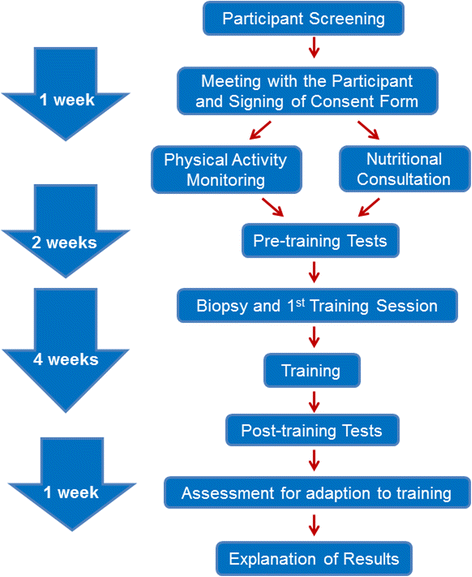The gene SMART study: method, study design, and preliminary findings
- PMID: 29143594
- PMCID: PMC5688409
- DOI: 10.1186/s12864-017-4186-4
The gene SMART study: method, study design, and preliminary findings
Abstract
The gene SMART (genes and the Skeletal Muscle Adaptive Response to Training) Study aims to identify genetic variants that predict the response to both a single session of High-Intensity Interval Exercise (HIIE) and to four weeks of High-Intensity Interval Training (HIIT). While the training and testing centre is located at Victoria University, Melbourne, three other centres have been launched at Bond University, Queensland University of Technology, Australia, and the University of Brighton, UK. Currently 39 participants have already completed the study and the overall aim is to recruit 200 moderately-trained, healthy Caucasians participants (all males 18-45 y, BMI < 30). Participants will undergo exercise testing and exercise training by an identical exercise program. Dietary habits will be assessed by questionnaire and dietitian consultation. Activity history is assessed by questionnaire and current activity level is assessed by an activity monitor. Skeletal muscle biopsies and blood samples will be collected before, immediately after and 3 h post HIIE, with the fourth resting biopsy and blood sample taken after four weeks of supervised HIIT (3 training sessions per week). Each session consists of eight to fourteen 2-min intervals performed at the pre-training lactate threshold (LT) power plus 40 to 70% of the difference between pre-training lactate threshold (LT) and peak aerobic power (Wpeak). A number of muscle and blood analyses will be performed, including (but not limited to) genotyping, mitochondrial respiration, transcriptomics, protein expression analyses, and enzyme activity. The participants serve as their own controls. Even though the gene SMART study is tightly controlled, our preliminary findings still indicate considerable individual variability in both performance (in-vivo) and muscle (in-situ) adaptations to similar training. More participants are required to allow us to better investigate potential underlying genetic and molecular mechanisms responsible for this individual variability.
Keywords: Genetic variants; Skeletal muscle; Training.
Conflict of interest statement
Ethics approval and consent to participate
The study protocol was approved by the Victoria University Human Research Ethics Committee (HRE13–223).
Consent for publication
Written informed consent was obtained from the individuals involved in this study.
Competing interests
The authors declare that they have no competing interests.
Publisher’s Note
Springer Nature remains neutral with regard to jurisdictional claims in published maps and institutional affiliations.
Figures





References
-
- Bouchard C, An P, Rice T, Skinner JS, Wilmore JH, Gagnon J, Perusse L, Leon AS, Rao DC. Familial aggregation of VO(2max) response to exercise training: results from the HERITAGE family study. J Appl Physiol (1985) 1999;87(3):1003–1008. - PubMed
-
- Hautala AJ, Makikallio TH, Kiviniemi A, Laukkanen RT, Nissila S, Huikuri HV, Tulppo MP. Cardiovascular autonomic function correlates with the response to aerobic training in healthy sedentary subjects. Am J Phys Heart Circ Phys. 2003;285(4):H1747–H1752. - PubMed
Publication types
MeSH terms
Substances
LinkOut - more resources
Full Text Sources
Other Literature Sources
Medical

